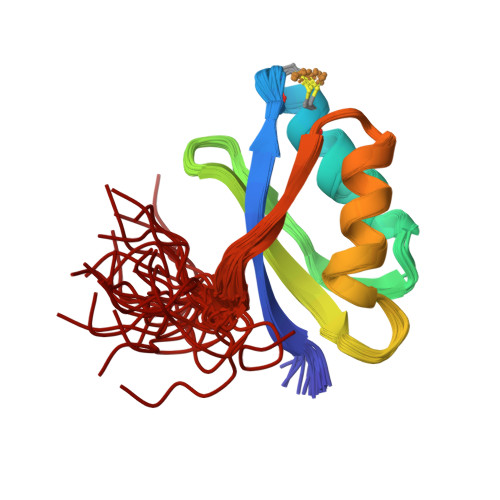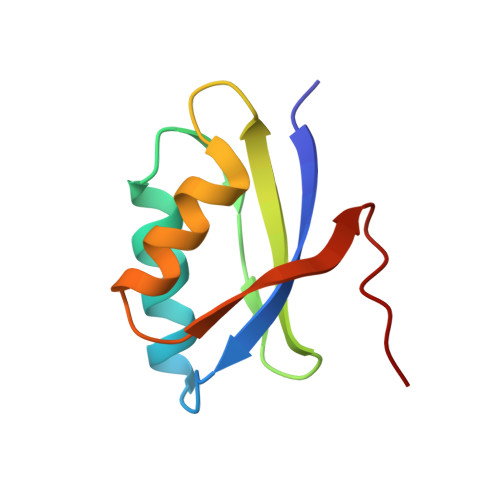Solution structure of the N-terminal domain of a potential copper-translocating P-type ATPase from Bacillus subtilis in the apo and Cu(I) loaded states.
Banci, L., Bertini, I., Ciofi-Baffoni, S., D'Onofrio, M., Gonnelli, L., Marhuenda-Egea, F.C., Ruiz-Duenas, F.J.(2002) J Mol Biology 317: 415-429
- PubMed: 11922674
- DOI: https://doi.org/10.1006/jmbi.2002.5430
- Primary Citation of Related Structures:
1JWW, 1KQK - PubMed Abstract:
A putative partner of the already characterized CopZ from Bacillus subtilis was found, both proteins being encoded by genes located in the same operon. This new protein is highly homologous to eukaryotic and prokaryotic P-type ATPases such as CopA, Ccc2 and Menkes proteins. The N-terminal region of this protein contains two soluble domains constituted by amino acid residues 1 to 72 and 73 to 147, respectively, which were expressed both separately and together. In both cases only the 73-147 domain is folded and is stable both in the copper(I)-free and in the copper(I)-bound forms. The folded and unfolded state is monitored through the chemical shift dispersion of 15N-HSQC spectra. In the absence of any structural characterization of CopA-type proteins, we determined the structure of the 73-147 domain in the 1-151 construct in the apo state through 1H, 15N and 13C NMR spectroscopies. The structure of the Cu(I)-loaded 73-147 domain has been also determined in the construct 73-151. About 1300 meaningful NOEs and 90 dihedral angles were used to obtain structures at high resolution both for the Cu(I)-bound and the Cu(I)-free states (backbone RMSD to the mean 0.35(+/-0.06) A and 0.39(+/-0.07) A, respectively). The structural assessment shows that the structures are accurate. The protein has the typical betaalpha(betabeta)alphabeta folding with a cysteine in the C-terminal part of helix alpha1 and the other cysteine in loop 1. The structures are similar to other proteins involved in copper homeostasis. Particularly, between BsCopA and BsCopZ, only the charges located around loop 1 are reversed for BsCopA and BsCopZ, thus suggesting that the two proteins could interact one with the other. The variability in conformation displayed by the N-terminal cysteine of the CXXC motif in a number of structures of copper transporting proteins suggests that this may be the cysteine which binds first to the copper(I) carried by the partner protein.
Organizational Affiliation:
Magnetic Resonance Center CERM and Department of Chemistry, University of Florence, Via Luigi Sacconi 6, Florence, Sesto Fiorentino, 50019, Italy.

















